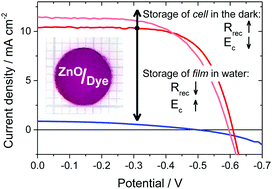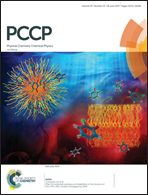Consequences of changes in the ZnO trap distribution on the performance of dye-sensitized solar cells†
Abstract
The well-established indoline dye D149 and three indoline dyes with improved binding stability (DN91, DN216 and DN285) were used as sensitizers for electrodeposited porous ZnO and studied in dye-sensitized solar cells and showed very similar cell characteristics. After storage of the cells in the dark for four weeks, an increase in short-circuit current density was observed. Electrochemical impedance spectroscopy served to detect a shift of the conduction band edge energy to lower energies and, hence, an increased injection efficiency of electrons from the excited state of the sensitizer to the ZnO conduction band is detected as the main cause of this change. Additional photoelectrochemical experiments at different illumination intensities, intensity modulated photocurrent and photovoltage spectroscopy (IMPS and IMVS), transient photocurrent measurements, as well as measurements of the open-circuit photovoltage decay (OCVD) were performed to confirm this conclusion and, further, to prove a reduced rate of recombination for these injected electrons which prevented a corresponding decrease in the open-circuit voltage for many cells, frequently observed earlier. It is therefore shown how the long-term stability of ZnO-based DSSCs can be improved.



 Please wait while we load your content...
Please wait while we load your content...